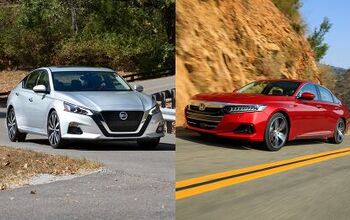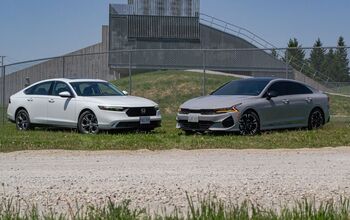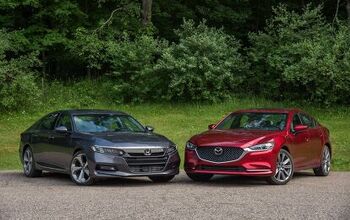Honda Accord vs Nissan Altima Comparison

Adapt to survive: it applies to sedans now, too.
It’s no secret that mid-sized sedans are an endangered species. In the last month we’ve seen both the Subaru Legacy and Chevrolet Malibu discontinued. Thus, the Honda Accord and Nissan Altima represent a full 40 percent of the remaining mainstream options out there (or half the field in Canada, where the Kia K5 quietly called it quits last year). Both of these four-door models have expanded their capabilities as part of this generation. The Altima added all-wheel drive to its repertoire; the Accord is now the only front-drive-only holdout, but includes an improved hybrid powertrain that is now standard equipment on higher trims.
An AWD gasser against a front-drive hybrid: two very different approaches to the same problem. Which one could lure us away from the ubiquitous crossovers? Managing editor Mike Schlee and I spent a week with both to find out.
Interior and cargo space
Honda Accord: The speed with which Honda’s latest corporate cabin design has spread makes the Accord’s interior feel instantly familiar. This is a classy and clean design, featuring appropriate use of soft-touch materials and a slim dashboard for maximized visibility. The mesh design hides the air vents in a more visually interesting way than other approaches. And as ever, those clicky climate control dials are a joy to use. The matte plastic panel surrounding the door controls feels flimsy, but otherwise, and we wouldn’t say no to a light-colored headliner for an airier feel, but otherwise the Accord’s cabin impresses.
While this particular Accord tester foregoes leather seats, the cloth items are supremely comfortable, with a gently curved cushion and ample lower back support. Honda still leans into the Accord’s car-ness too, with a seat mounting that is appreciably low for a more connected feel.
The Accord has been toeing the line between mid- and full-size for over 15 years now. This latest model continues to offer stretch-out levels of room, especially in the rear where passengers can enjoy a full 40.8 inches (1,036 millimeters) of legroom. The thick C-pillar and dark headliner do make for a less inviting space, however. Meanwhile, the lower overall height does give the Accord less headroom than its competitor. The Accord has squarer shoulder and hip room: a little less than the Altima for the former, but more for the latter.
Trunk space is a segment-best 16.7 cubic feet (473 liters), though the wheelarches are tall, limiting the ability to fit larger items.
Nissan Altima: Like the Accord, the Altima follows a familial design language. Unfortunately, it’s a little more Sentra than Rogue or Ariya, and thus a little dated by today’s standards. Most controls are easy to use so there’s no problems there, but they lack the satisfying tactility of those in the Honda. That faux carbon fiber isn’t fooling anybody, either. Nissan’s thin-rimmed, flat-bottom steering wheel earns praise, however. Same goes for the light-colored pillars and headliner.
The Altima tester is the sporty SR trim, which includes niceties such as orange contrast stitching and nicely patterned leather seats. I don’t find them quite as comfortable as the Honda’s thrones, mostly because of a flat cushion, but there’s a good range of adjustment and the passenger gets power, something you won’t find in the Accord.
While the Nissan gives up a few inches in wheelbase and length, its interior measurements are largely similar to the Accord. In fact, in more than few ways it beats the big H. The one exception—and it’s a big one—is second-row legroom, which at just 35.2 inches (894 mm) is nearly half a foot less. Honestly, it’s fine for most adults, but there will be knee/seat interactions that simply won’t happen in the Accord.
The Altima’s trunk is slightly smaller at 15.4 cubic feet (436 L), but the advantage is a slightly less irregular shape to work with.
Bottom Line: While the Altima’s leather seats might suggest it’s the nicer cabin, the Accord has the more quality feel. It also offers up more space, enough to earn it the first win in this face-off.
Honda Accord vs Nissan Altima: Tech and Features
Accord: Getting into a hybrid Accord means bringing its larger 12.3-inch touchscreen into the cabin. You won’t get Google Built-In, which remains tied to the top Touring trim, but there is wireless Android Auto and Apple CarPlay, so it’s not much different. The system employs a few permanent menu buttons on the left side of the screen (plus a customizable spot), Honda’s usual color-coded main menu, and an available split-screen function. It’s easy to use and quite quick in its responses, though you won’t find native navigation here. The Accord’s eight-speaker audio system is fine.
There is a long list of standard driver assistance tech for the Accord Sport. From blind spot monitoring and rear cross-traffic alert to full-range adaptive cruise control with Traffic Jam Assist, the Accord offers just about everything across the hybrid board. The notable exception? A 360-degree camera, which the Altima does offer on its top trim.
Altima: Nissan has a knack for including plenty of features on its mid-trims and the Altima follows suit. This tester includes native navigation, heated front seats, a power-adjustable passenger seat, Wi-Fi hotspot, wireless charger, and more. In Canada, the SR Premium also bundles the nine-speaker Bose audio system into the deal; America leaves that to the top-shelf SL. That makes the Altima the audio choice, at least up North.
Matching the Honda in size and basic layout, the Nissan’s 12.3-inch touchscreen is about as easy to use. It isn’t as pretty mind you, and seems just a little slower on the uptake. Thankfully, it too offers wireless Apple CarPlay and Android Auto.
Nissan’s safety list is similarly lengthy, but also has regional changes. America misses out on ProPilot Assist here, a strange omission as it’s an option on the lower SV FWD trim. Canada includes the setup on both the SR Premium and Platinum, plus traffic sign recognition. ProPilot Assist is a smooth and easy system to use, with natural throttle and brake applications. The rest of the assists are largely the same as those on the Accord. The Altima’s rear-view camera is notably grainy, however.
Bottom Line: The Accord sacrifices a few features, most notably a wireless charger, native navigation, and an uplevel audio system. The Nissan is better equipped—especially in Canada—and thus earns the nod here.
Powertrain, Driving Feel, and Efficiency
Accord: The Honda utilizes a 2.0-liter engine along with an electric motor. The former produces 146 horsepower on its own; the latter, 181 hp. Thanks to a complicated setup I won’t dive into detail here for, the combined system power is 204 hp, while torque peaks at a helpful 247 pound-feet.
The result is the opposite of the peaky VTEC experience that Honda was known for in the ‘90s: this is a torquey, smooth performer. Much of the rubberbanding found in earlier Hondas has been banished: we still get those occasional disconnects between engine noise and forward progress, but they’re few and far between. In day-to-day operation, this is the quicker car here, both in outright power and responsiveness.
Needless to say, the hybrid is the winner of the fuel economy battle too. Without trying, we surpass the official fuel economy figures, which is 44 mpg combined (5.3 L/100 km).
Despite the trim name and those 19-inch alloy wheels, the Accord provides a smooth, pampering ride. The multi-link setup soaks up bumps big and small, and there’s precious little noise as it does so. Thank the separation of passenger and storage spaces: you can’t do that with an SUV. The steering is well-weighted and accurate, making it easy to thread this long sedan through city streets. Visibility is also good, save for the afore-mentioned C-pillars.
Altima: Every Altima save for the US-only VC-Turbo uses the familiar 2.5-liter four-cylinder engine. Going with AWD—now standard in Canada—drops the four-pot’s outputs to 182 hp and 178 pound-feet of torque. Since it’s down on power, perhaps the Altima has the lighter curb weight to offset the disadvantage? It does, but not by much: 3,442 lb is a grocery shop away from the Accord’s 3,477 lb.
Naturally, this makes the Altima the tardier of this duo. It’s wholly fine for day-to-day of course, even shorter highway on-ramps, but we’d be lying if we didn’t miss the Accord’s instant-access torque. The Altima’s CVT has to set its engine in Drone Mode to extract what meagre performance there is, so it’s not a fun experience that way, either.
30 mpg for an AWD family sedan is pretty decent, it’s a long ways from the fuel-sipping Honda. We just hit that figure during the week.
Similarly, the rest of the Altima driving experience lacks the maturity of the Accord. There’s nothing wrong with the steering, which is appropriately light and just as accurate as the Accord’s. No, it’s the suspension, which can be brittle on less than ideal roads. At highway speeds, a light vibration would form, seemingly originating from the front driver’s side.
While we didn’t get to test the Altima’s AWD through an inclement weather, we feel it’s important to note its 5.4 inches (137 mm) of ground clearance bests the Accord by only a tenth of an inch.
Bottom Line: The Accord offers a noticeable improvement over the not-so-compact sibling that sits under it. The Altima does not. With the enormous gas savings (over $500 a year at current estimates), it’s an easy pick.
Honda Accord vs Nissan Altima: Styling
Accord: The Accord has long been a conservative machine, and the latest model is no different. The full-width taillight treatment is probably the most adventurous aspect, in a way recalling the NSX-aping Accord Coupe of the late ‘90s. This new shape is very sensitive to color and wheel choice: red is always good, while the thin-spoked 19-inchers seen here work well to our eyes. The design emphasizes the long, low, and wide stance of the new model.
Altima: There’s something almost Audi S5-like about the Altima’s angular headlights and clamshell hood. In profile, the character line simply continues to angle up towards the tail, instead of the graceful arc on the Honda, giving the Altima a distinctly sportier stance (and shallower window line). Reinforcing that look is a pinched tail with two exhaust tips poking out. The Altima also might have the coolest wheels in the mid-sized game right now, a wicked, twisty two-tone look that includes “SR” on one of the spokes. With apologies to Nissan, I’m calling the design the “dancing octopus.”
Bottom Line: The Accord does current conservative Honda well, while Altima has more fun.
Pricing and Value
Accord: This Sport is the most affordable way to get an electrified Accord in either the US or Canada. For $33,990 ($41,684 CAD) including destination, buyers get a well-rounded package that includes the larger infotainment screen, 19-inch alloys, and eight-speaker audio system. The only additional cost on our tester is the red paint, which bumps the price by $455 ($300 CAD) to $34,445 ($41,984 CAD).
It’s important to note that our tester, being a Canadian model, includes standard heated front seats and steering wheel. In America, buyers also have the pricier EX-L and Sport-L trims should they want more features in their hybrid, including those. In both Canada and the US, the top Accord trim is the $39,985 ($46,830 CAD) Touring.
Altima: Like the Accord, this is a mid-level model in the Altima hierarchy. The SR AWD starts at $31,210 ($36,528 CAD) including destination, plus the SR Premium package ($2,890 / $2,200 CAD) and premium Ethos Gray paint ($425 / $300 CAD), which sadly appears to be unavailable on the configurator now. The final tally: an as-tested price of $34,525 ($39,028 CAD).
In America, the front-drive Altima SL starts at $34,210, and adding AWD is another $1,500. Meanwhile the more powerful SR VC-Turbo stays as the flagship for $37,210. In Canada, only the Altima Platinum ($42,815 CAD) exists beyond our tester.
Bottom Line: In America, the Accord is a whole $80 cheaper than the Altima; in Canada, it’s nigh-on three-grand pricier. That makes it a harder one to justify north of the border, even based on the potential gas savings—but we’d still do it. In America, it’s an even easier choice.
Honda Accord vs Nissan Altima: Verdict
The Altima does a good job of addressing the modern customer’s needs. It packs in a lot of content over its Honda opponent, while boasting additional bad-weather grip and sporty looks. Even with last year’s face lift though, the Altima’s meh driving experience feels a generation behind the smooth-operating Accord.
It’s not the most interesting vehicle to look at, but the latest Accord is a reminder of why mid-sized sedans were once the sales goliaths of the industry. With the sort of mature ride a compact SUV simply can’t match, acres of space, and those easily-achievable fuel economy figures, the Accord is borderline luxury car at this point. With that, it justifies its place not only above the Altima in this comparison, but above the Civic as well. Adapt and survive.
Become an AutoGuide insider. Get the latest from the automotive world first by subscribing to our newsletter here.

Kyle began his automotive obsession before he even started school, courtesy of a remote control Porsche and various LEGO sets. He later studied advertising and graphic design at Humber College, which led him to writing about cars (both real and digital). He is now a proud member of the Automobile Journalists Association of Canada (AJAC), where he was the Journalist of the Year runner-up for 2021.
More by Kyle Patrick













































Comments
Join the conversation
Accord has dull and unimpressive styling from the front and looks like a grandpa's car
Have you tried Global Dominion Financing Inc. for car financing or car refinancing (Sangla OR/CR)?